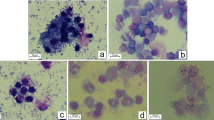Abstract
Hypochlorous acid (HOCl) at concentrations of 6.25 μM and greater caused statistically significant, dose-related inhibition of mitogen-activated proliferation of human mononuclear leucocytes (MNL). The anti-proliferative effects of HOCl, which were evident using both undepleted and adherent-cell depleten MNL, could not be attributed to decreased mitogen binding by HOCl-treated cells. The anti-oxidants ascorbate and cysteine (50 μM), when added to MNL prior to exposure to HOCl (25 μM), prevented the anti-proliferative effects of the oxidising agent. Likewise reversal of oxidant-mediated inhibition of the responsiveness of MNL to mitogens was observed when ascorbate and cystein were added after HOCl treatment of the cells. These results suggest that HOCl, derived from activated phagocytes, is a potential mediator of immunosuppression, especially in the setting of abnormal host anti-oxidant defences.
Similar content being viewed by others
References
D. E. Van Epps, J. A. Frierson and R. C. Williams,Immunological studies of anergic patients. Infect. Immun.10, 1003–1009 (1974).
F. S. Kantor,Infection, anergy and cell-mediated immunity. N. Engl. J. Med.292, 629–634 (1975).
S. I. Wolinsky, J. S. Goodwin, R. P. Messner and R. C. Williams,Role of prostaglandin in the depressed cell-mediated immune response in rheumatoid arthritis. Clin. Immunol.17, 31–37 (1980).
D. P. Braum, M. A. Cobleigh and J. E. Harris,Multiple concurrent immunoregulatory defects in cancer patients with depressed PHA-induced lymphocyte DNA-synthesis. Clin. Immunol. Immunopathol.17, 89–101 (1980).
D. A. Carson, S. Seto and D. B. Wasson,Lymphocyte dysfunction after DNA damage by toxic oxygen species: a model of immune dysfunction. J. Exp. Med.163, 746–751 (1986).
A. L. Sagone, S. Kamps and R. Campbell,The effect of xidant injury on the lymphoblastic transformation of human lymphocytes. Photochem Photobiol.28, 909–915 (1978).
Y. nishida, K. Tanimoto and I. Akaoka,Effect of free-radicals on lymphocyte-response to mitogens and rosette formation. Clin. Immunol. Immunopathol.19, 319–324 (1981).
D. C. Zoschke and R. P. Messner,Suppression of lymphocyte mitogenesis by phagocyte-released oxygen species: comparative activities in normal and in chronic granulomatous disease. Clin. Immunol. Immunopathol.32(1), 29–40 (1984).
A. El Hag, P. E. Lipsky, M. Bennett and R. A. Clark,Immune modulation by neutrophil myeloperoxidase and hydrogen peroxide: differential susceptibility of human lymphocyte functions. J. Immunol.136, 3420–3426 (1986).
D. C. Zoschke and N. D. Staite,Suppression of human lymphocyte proliferation by activated neutrophils or H 2 O 2:surviving cells have an altered T-helper/T-suppressor ratio and an increased resistance to secondary oxidant exposure. Clin. Immunol. Immunopathol.42(2) 160–170 (1987).
N. D. Staite, R. P. Messner and D. C. Zoschke,Inhibition of human T lymphocyte & rosette formation by neutrophils and hydrogen peroxide: differential sensitivity between helper and suppressor T lymphocytes. J. Immunol.139, 2424–2430 (1987).
I. M. Allan, J. Lunec, M. Salmon and P. A. Bacon,Reactive oxygen species selectively deplete normal T-lymphocytes via a hydroxyl radical dependent mechanism. Scand. J. Immunol.26, 47–53 (1987).
A. El Hag and R. A. Clark,Immunosuppression by activated human neutrophils. Dependence on the myeloperoxidase system. J. Immunol.139, 2406–2413 (1987).
R. Anderson,Ascorbate-mediated stimulation of neutrophil motility and lymphocyte transformation by inhibition of the peroxidase/H 2 O 2 /halide system in vitro and in vivo. Am. J. Clin. Nutr.34, 1906–1911 (1981).
R. Anderson and P. T. Lukey,A biological role for ascorbate in the selective neutralization of extracellular phagocytederived oxidants. Ann. NY Acad. Sci.498, 229–247 (1987).
S. J. Klebanoff,oxygen-dependent cytotoxic mechanisms of phagocytes. In:J. I. Gallin andA. S. Fauci (Eds., Advances in host defense mechanisms. Raven Press NY. 111–162 (1982).
R. Anderson and A. J. Van Rensburg,The in vitro effects of proproanolol and atenolol on neutrophil motility and postphagocytic metabolic activity. Immunol.37, 15–24 (1979).
A. Böyum,Isolation of leucocytes from human blood. Further observations: methylcellulose, dextran and ficoll as erythrocyte aggregating agents. Scand. J. Clin. Lab. Invest.21, 31–50 (1968).
B. Halliwell, M. Wasil and M. Grootveld,Biologically significant scavenging of the myeloperoxidase-derived oxidant hypochlorous acid by ascorbic acid. FEBS Letters.133, 1488–1494 (1987).
S. Weiss,Tissue destruction by neutrophils. N. Engl. J. Med.320 (6), 365–376 (1989).
E. Beutler,Red Cell Metabolism. A Manual of Biochemical Methods. 3rd Edition, pp. 65–66, Grune & Stratton London 1984.
Author information
Authors and Affiliations
Rights and permissions
About this article
Cite this article
Smit, M.J., Anderson, R. Inhibition of mitogen-activated proliferation of human lymphocytes by hypochlorous acidin vitro: Protection and reversal by ascorbate and cysteine. Agents and Actions 30, 338–343 (1990). https://doi.org/10.1007/BF01966297
Received:
Accepted:
Issue Date:
DOI: https://doi.org/10.1007/BF01966297



